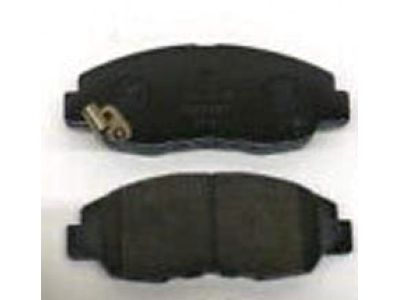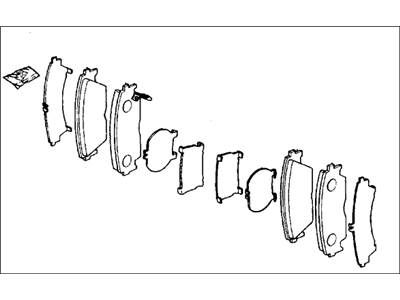×
- Hello
- Login or Register
- Quick Links
- Live Chat
- Track Order
- Parts Availability
- RMA
- Help Center
- Contact Us
- Shop for
- Honda Parts
- Honda Accessories

My Garage
My Account
Cart
Genuine Honda Prelude Brake Pad Set
Disc Brake Pad Set- Select Vehicle by Model
- Select Vehicle by VIN
Select Vehicle by Model
orMake
Model
Year
Select Vehicle by VIN
For the most accurate results, select vehicle by your VIN (Vehicle Identification Number).
31 Brake Pad Sets found
Honda Prelude Pad Set, Front Brake (16Cl-13Vn)
Part Number: 45022-SF1-020$44.30 MSRP: $63.10You Save: $18.80 (30%)Honda Prelude Set, Pad Rear (9Clp-1)
Part Number: 43022-SV4-A23$47.46 MSRP: $67.03You Save: $19.57 (30%)Honda Prelude Pad Set, Rear (11Cl-14S, N601)
Part Number: 43022-SL5-000$47.46 MSRP: $67.03You Save: $19.57 (30%)Honda Prelude Pad Set, Front (16Cl-13Vn)
Part Number: 45022-SF1-526$8.93 MSRP: $75.40You Save: $66.47 (89%)Honda Prelude Pad Set, Front Brake (16Cl-13Vn)
Part Number: 45022-SF1-010$44.67 MSRP: $63.10You Save: $18.43 (30%)Honda Prelude Pad Set, Brake (17Cl-14V)
Part Number: 45022-SD4-010$44.67 MSRP: $63.10You Save: $18.43 (30%)Honda Prelude Pad Set, Brake (17Cl-14Vn)
Part Number: 45022-SD4-A11$44.67 MSRP: $63.10You Save: $18.43 (30%)Honda Prelude Pad Set, Front Brake (17Cl-14Vn)
Part Number: 45022-SD4-A12$44.67 MSRP: $63.10You Save: $18.43 (30%)
| Page 1 of 2 |Next >
1-20 of 31 Results
Honda Prelude Brake Pad Set
Brake Pad Set are used in Honda Prelude automobile as a part of the braking system that converts kinetic energy to thermal energy through rubbing against the brake rotors and thereby slowing down the vehicle. These Brake Pad Set are normally a metal backed organic composition and, thus, may stand high temperature, usually, up to 400 degrees Fahrenheit under normal usage. Several forms of Brake Pad Set have been used in Honda Prelude models, namely non- metallic, semi metallic, fully metallic, and ceramic. Both types have their pros and cons concerning resistance to friction, wears, as well as: and noise. Periodic maintenance is indispensable, the Brake Pad Set must be replaced every 50,000 miles, the use of proper hardware is significant for the increase of the Brake Pad Set' performance and their lifespan in vehicles of Honda Prelude.
In search of affordable OEM Honda Prelude Brake Pad Set? Consider browsing through our extensive inventory of genuine Honda Prelude Brake Pad Set. Not only do we provide market-leading prices and a manufacturer's warranty, but we also pride ourselves on exceptional customer service and swift delivery.
Honda Prelude Brake Pad Set Parts Questions & Experts Answers
- Q: How do you remove and install brake pads on Honda Prelude?A: To replace the brake pads the following should be done, first use a syphon or turkey baster to pull of half the brake fluid from the master cylinder, flush the reservoir with approved brake cleaner and then pour half a brake fluid into the reservoir. Securely lift the car using jackstands and then, loosen or fully remove the front tyre and wheel components. If required, the brake hose mounting bolts on the steering knuckle should be removed. When replacing brake pads on one side of a vehicle it is recommended that brake pads on the other side also be replaced if possible, but if not at least do one side before starting the other. Time is spent in a singular manner on one of the Brake Calipers-while the lower caliper bolt is unscrewed to align the caliper and render it out of the way, so the brake pads, shims, and retainers can be removed. Check the thickness of the brake pads; if they are worn-out to the requisite level, then replace them. The brake rotor must be inspected for crack, overheated, uneven surface or sharp edges, measurement the thickness if it is below the specified limit it should be replaced. Inspect the caliper brackets and lubricate the sliding pins with high-temperature brake grease; on the brake pad backing tabs and their slots apply anti-seizing compound. Check the installation of all retainers and shims and align the wear indicators, where used. If replacing pads, it is necessary to push back the brake caliper piston into the caliper body, after it is cleaned. The new brake pads must be installed and the caliper must be pivoted back down before it is bolted back into position. Make sure it is full and add some more if needed to the master cylinder. After that installation is done, apply pressure on the brake pedal in short pulls until the pedal force rises to a solid firmness and do not apply too much pressure in order not to damage the internal seals and then go through several brake holding episodes while the brake pedal is depressed. Last but not least, do a road test, taking approximately 200 miles for new pads to bed-in. brake pads should be inspected every 6,000 miles or during every oil change, and one must look on both the ends of the outward brake pads and the thickness of the inner brake pads. Check the outer pad through the inspection hole in the caliper, replacing any pads if the friction material is worn to within 0.030 inch of the steel backing or if you have riveted type pads, and worn to within 0.030 inch of any rivet head. Disc brake pads should always be replaced in sets in order to avoid axle set problems and uneven wearing of the brake system. Take out the brake pads for making certain of them and to the measure the thickness of the pad's friction material only, that is the composite material excluding the metal backing plate and if this assessment is not adequate to confirm the pads' genuineness, then withdraw the caliper for the pads.
Related Honda Prelude Parts
Browse by Year
2001 Brake Pad Set 2000 Brake Pad Set 1999 Brake Pad Set 1998 Brake Pad Set 1997 Brake Pad Set 1996 Brake Pad Set 1995 Brake Pad Set 1994 Brake Pad Set 1993 Brake Pad Set 1992 Brake Pad Set 1991 Brake Pad Set 1990 Brake Pad Set 1989 Brake Pad Set 1988 Brake Pad Set 1987 Brake Pad Set 1986 Brake Pad Set 1985 Brake Pad Set 1984 Brake Pad Set 1983 Brake Pad Set 1982 Brake Pad Set 1981 Brake Pad Set 1980 Brake Pad Set 1979 Brake Pad Set

































